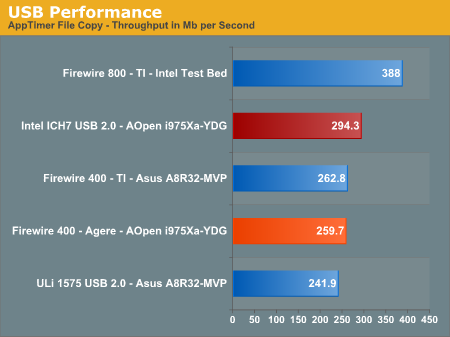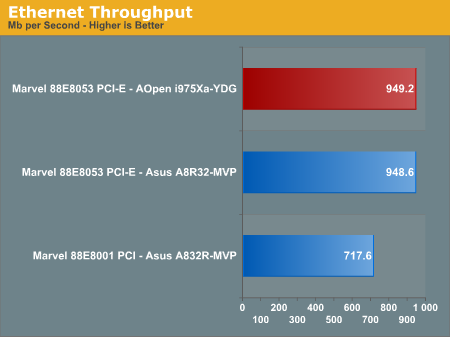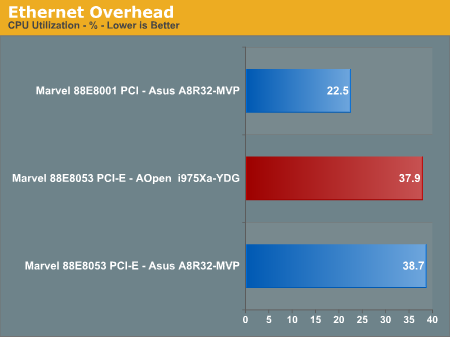Intel Core Duo: AOpen i975Xa-YDG to the Rescue
by Gary Key on May 4, 2006 8:00 AM EST- Posted in
- Motherboards
Firewire and USB Performance
After looking at many options for Firewire and USB testing, we finally determined that an external USB 2.0, Firewire 400, and Firewire 800 hard disk would be a sensible way to look at USB and Firewire throughput. We utilize a RAM disk as our "server", since memory removes almost all overhead from the serving end. We turn off disk caching on the USB and Firewire side by setting up the drives for "quick disconnect" so our results are consistent.We use 2GB of fast 3-3-3-8 system memory set up as a 450MB RAM disk and 1550MB of system memory. Our standard file is the SPECviewPerf install file, which measures 432,533,504 bytes (412.4961MB). After copying this file to our RAM disk, we measured the time for writing from the RAM disk to our external USB 2.0, Firewire 400, or Firewire 800 drive utilizing our internal Windows based timing program. The copy times in seconds were then converted into Megabits per second (Mb) to provide a convenient means of comparing throughput. Higher Rates therefore mean better performance in this particular test.

Possibly the most interesting finding in our Firewire and USB throughput tests is the outstanding performance of an external hard drive connected to Firewire 800. Our benchmarks show Firewire 800 is up to 48% faster than a drive connected to the more common Firewire 400, and about 32% faster than the fastest USB 2.0 solution.
The AOpen board offers the Agere based IEEE 1394 Firewire option that provides very competitive performance with the more common TI chipset solutions. The Intel USB 2.0 performance offers 22% better performance than the ULi based controller in throughput.
Ethernet Performance
The current motherboard test suite includes LAN performance measurements. All of these boards utilize PCI or PCI Express based controllers with the only difference being the supplier of the core logic.The Windows 2000 Driver Development Kit (DDK) includes a useful LAN testing utility called NTttcp. We used the NTttcp tool to test Ethernet throughput and the CPU utilization of the various Ethernet Controllers used on the Intel motherboards.
We set up one machine as the server; in this test, an Intel system with an Intel CSA Gigabit LAN connection. Intel CSA has a reputation for providing fast throughput and is a logical choice for our Gigabit LAN server.
On the server side, we used the following Command Line as suggested by the VIA whitepaper on LAN testing:
Ntttcpr -m 4,0,‹server IP› -a 4 -l 256000 -n 30000
Ntttcps -m 4,0,‹client IP› -a 4 -l 256000 -n 30000


AOpen's choice of the Marvell 88E8053 10/100/1000Mb/s Ethernet controller is an excellent addition to this board. The performance is basically equal to that of the same Marvell 88E8053 controller utilized on the Asus board. The lower CPU utilization rate on the Marvel 88E8001 PCI controller is directly attributable to the lower throughput numbers generated in our tests.










81 Comments
View All Comments
Per Hansson - Wednesday, May 17, 2006 - link
Hi Gary, just wanted to drop in and give you a kudos on this very nice review!It also makes me smile to finally see Intel catching up with AMD, this can only be good news for the customer...
And a small heads up, there are a few Intel Core Duo Engineering sample CPU's on sale at eBay, "hint hint engineering sample=multipler unlocked"
And also a big thanks for finally posting those capacitor shots and mentioning them, keep up the good work!
Also I think Aopen deserves recognition for designing a mainboard with so high-quality components, Rubycon=Way to go!!!
goinginstyle - Friday, May 19, 2006 - link
Agreed....
vailr - Thursday, May 4, 2006 - link
Updated driver:(from: http://www.station-drivers.com/page/intechip.htm)">http://www.station-drivers.com/page/intechip.htm)
Intel Chipset software Installation Utility
Version 7.3.1.1013 - Windows 2000/XP 32/64bits/2003Server Multi Langues & officiel
ftp://aiedownload.intel.com/df-support/10392/eng/i...">ftp://aiedownload.intel.com/df-support/10392/eng/i...
Version 8.0.0.1005 Alpha
Windows 2000/XP 32/64bits/2003Server Multi Langues & non officiel
http://www.station-drivers.com/telechargement/inte...">http://www.station-drivers.com/telechargement/inte... Alpha.exe
Gary Key - Thursday, May 4, 2006 - link
Thank you for posting these links. :) We have a policy of utilizing the latest driver sets on a supplier's website at the time our testing starts, in this case the Intel general download page is still posting the 7.2.2.1006 driver set. However, I am using the 7.3.1 driver set on our retail board sample tonight. ;-)irev210 - Sunday, May 7, 2006 - link
Hello Gary,Sorta funny how that other fellow has absolutely no idea what he is talking about.
I just wanted to touch upon something that I didnt see get much attention.
You should have mentioned in your article about how efficient the core architecture is, and how well it scales with increased frequency. The chip turns into a total monster once you get past 3ghz, and continues to perform better and better as you increase the speed. The fastest I could get on air was around 3.1ghz. I wouldnt be afraid to crank the volts to the 1.5 max on the aopen board... with a different cooler, you should hit some nice speeds. Try swapping out for a zalman 9500, or a big typhoon.
The shortfalls, are as you mentioned the southbridge lacking raid, and the poor bios options. Vcore should let us up to 1.65-1.7, while Vdimm should let us do atleast 2.3.
While this may not satisfy the most serious enthusiast, this board does fill a nice niche. The price is pretty high, but core duo CPU's can be had on the cheap, which makes up for it. For someone that is worried about their electric bill, and wants performance and performance per watt, this is a great alternative.
For others who must have the fastest. This just makes them drool. This is the low end of the core architecture. Merom and Conroe to follow... we shall be stunned.
Consdering Meroms being tested now at 3.0Ghz are faster than 3.2Ghz Yonah's... AND YOU WILL SEE Conroe EE at 3.33 w/ a 1333fsb doing 4ghz w/ 1500mhz FSB :)
For those that dont get it yet... AMD will need a AM2 processor running at about oh 4.8Ghz to beat a 4Ghz clocked conroe :)
Good things to come. I take no sides, im just excited about new stuff :)
Marlowe - Thursday, May 4, 2006 - link
How come a ~1 % cpu usage translates into a massiv 20 fps drop in BF2? Looks like EA have a deal with Creative :(A lot of world records have been beaten with this mobo already over here at XS :)
coolaler even got SLI enabled on it ;) also running a merom in it ;)
Your 266 FSB is very good and about normal for aircooling. Give it some cold and it will go further ;)
Frumious1 - Thursday, May 4, 2006 - link
[font color="#000000] (Damn white text. Nice comment engine AnandTech.... Need a new programmer?)Because RightMark is a theoretical test and not actually a real game or audio application. Also, look at the 3D/EAX scores - it's more than 1% CPU usage, but still less than 20% or whatever.
Gary Key - Thursday, May 4, 2006 - link
It has to do with the Realtek driver load and Creatives to some extent being split between the cores during the RightMark testing. I noted in the text that although the cpu utilization is extremely low in our Rightmark results due to the load balancing that the actual game results (percentage differences) were basically the same as our single core scores. The drop in BF2 is due to the audio algorithms being generated by the CPU rather in hardware as on the X-FI card. Our audio settings in BF2 are set to hardware, medium quality, EAX enabled, the high quality setting extracts another 6FPS but we generally have not noticed an increase in audio quality. This is one penalty you pay for on-board audio in a CPU limited game although Serious Sam II is the one exception for either solution.
We are hoping to receive a T2700 chip from Intel shortly and will "chill" it to see what results come from it. :) Yes, we had SLI working on the board also, but that is a topic that will be buried with Jimmy Hoffa at this time. ;-)
NT78stonewobble - Friday, May 5, 2006 - link
Intriguing last 2 sentences.The comments section has some really good info alot of the time :).
And kudos for bringing into the review something about the penalty for using onboard audio versus dedicated hardware.
You're not by any chance planning on writing something about audio quality some-time? Not that im an audiophile or the like, just curious.
Gary Key - Friday, May 5, 2006 - link
We will expand our audio section in the next update to our motherboard review section. We are looking at several variations of the review process as we enter a very busy time of the year with AM2, Conroe, and others all launching over the next 90 days. :)